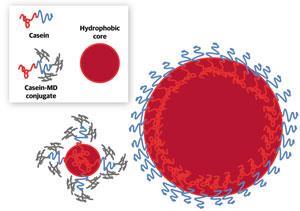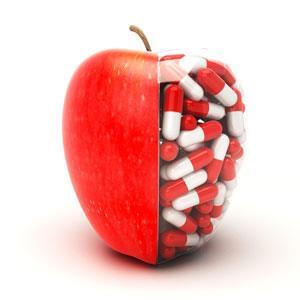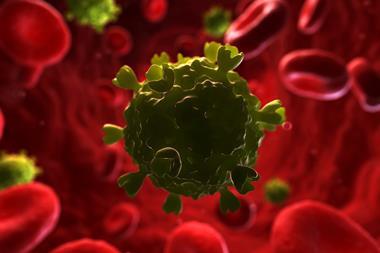Compounds normally thought of as medicines are being added to food. Elinor Hughes looks at the scientific and regulatory challenges facing these nutraceuticals.
Compounds normally thought of as medicines are being added to food. Elinor Hughes looks at the scientific and regulatory challenges facing these nutraceuticals.

‘Let food be thy medicine and medicine be thy food,’ said Hippocrates, Greek physician in the fifth century BC in Athens, known as the father of western medicine. Now, in the 21st century, researchers are putting their own spin on the saying by investigating ways to incorporate medicinal compounds in our food.
‘Health-promoting compounds added to foods are usually termed “nutraceuticals”,’ says Yoav Livney, associate professor at the biotechnology and food engineering department, Technion, Israel Institute of Technology, in Haifa, Israel. The word itself is a combination of nutrition and pharmaceutical, but there’s ‘no real consensus about what a nutraceutical is’, says Amanda Wright, director of the Human Nutraceutical Research Unit at the University of Guelph in Canada. ‘What I tell my students is that it’s a product isolated from a food that is sold in medicinal form and has some benefit physiologically beyond basic nutritional requirements.’ She adds that a nutraceutical could also be added back to the food, making a so-called functional food. ‘This would look like a food, behave like a food, but it would have some constituent that provides additional benefit,’ says Wright.
Fortifying food with extra nutrients is nothing new. We are used to seeing cereals labelled as ‘fortified with vitamins and iron’, for example. And in the US and Canada, flour is enriched with folic acid, a compound that pregnant women are advised to take to prevent neural tube birth defects such as spina bifida. You may also have noticed the rise of margarines that contain plant sterols that promise to lower low density lipoprotein (or ‘bad’) cholesterol. These are just a couple of examples of additives in foods that have been specially introduced to tackle serious health problems with very little change to our lifestyles. Now, there is increase in research into adding nutrients to food to prevent or cure diseases.
‘People are looking more at lifestyle factors to prevent and manage disease and, of course, diet is a huge part of that,’ says Wright. So what do scientists want to put into food to confer health benefits? ‘There’s a huge spectrum of ingredients, of medicinal compounds,’ says Wright. Some of the interest is in finding dietary-based constituents, especially those that have similar effects to actual drugs. For example, polyunsaturated fatty acids and fish oils may have blood-thinning activity similar to warfarin. They are also seen as being more ‘natural, whatever that means’, she says, with potentially fewer side effects.
Delivering the goods
Wright’s own interest lies in delivering carotenoids into the body. Carotenoids are a class of lipids and include molecules like beta-carotene d lutein. Beta-carotene is found in carrots and has provitamin A activity, which means that it is converted to vitamin A in the body. A lack of vitamin A can lead to blindness. Lutein, found in green leafy vegetables, prevents age-related macular degeneration. ‘As people age, you could have a dietary strategy including foods or nutraceuticals containing lutein that might actually prevent age-related macular degeneration,’ says Wright. Gut health is another large research area, she points out, and researchers are working on ways to ensure that probiotics can reach the lower intestine where they are believed to have a beneficial effect. To do this requires them being packaged into capsules, tablets or added into food formulations in which they can survive processing in the stomach.
Packaging up nutraceuticals to deliver their health benefits seems to be increasingly important area of research. But, as Wright admits, there is no magic bullet. ‘No one structure seems to be appropriate for all situations. If a nutraceutical is going to be put into a tablet, that’s going to be different to what can be add to a beverage for example.’ And that’s not all. Researchers have to consider the food to which the nutraceutical is added, to ensure that the food itself does not break down the capsule. ‘You could have acidic matrix or there may be pro-oxidants present. Things like that are going to drive the nature of the encapsulate structure that may be required,’ she says. They also have to consider the high temperature manufacturing involved in food production and the shelf life of the product. Another target is bioavailability – the nutraceutical has to be able to be absorbed and reach systemic circulation so that it can exert its health benefit. To this end, research has focused on making the nutraceutical stable in the stomach but able to be absorbed in the small intestine.

Livney’s team has been developing various nanodelivery systems for nutraceuticals using natural food biopolymers, such as proteins and polysaccharides. One of their achievements was to make nocapsules for hydrophobic nutraceuticals from conjugates of a protein and oligosaccharide. They then load them with a hydrophobic nutraceutical, vitamin D, which prevents rickets. Their plan was to add the capsules to clear drinks, so the capsules need to be small enough not to cause cloudiness but still be able to protect their contents. Not only did the capsules hold onto the vitamin, but in tests they also protected it from the acidic conditions in the stomach. Livney predicts that the capsule will only release its contents when it reaches the small intestine, where enzymes will break down the saccharide–protein structure. Another benefit of the coating, he says, is that it protects the vitamin D during refrigerated shelf-life before consumption.
Another consideration is how the additives are going to affect the look, smell, taste and texture of the food. In another project, Livney’s team show that heat-treated beta lactoglobulin (other milk protein) can entrap and protect green tea epigallocatechin gallate (EGCG, link to the prevention of neurodegenerative and cardiovascular diseases, as well as cancer) from degradation in clear drinks. The capsule can also suppress EGCG’s bitterness and astringency, which limited its addition to beverages. ‘Currently, we are studying the interaction of these nanodelivery systems with the human digestive tract, to facilitate high bioavailability and protection of the bioactive compounds during digestion,’ says Livney.
Nanosized nutrition
‘One must be careful when designing and utilising food-grade nanoparticles to ensure that they do not have any adverse effects on human health,’ warns Julian McClements from the department of food science at the University of Massachusetts, US. He adds that there are a number of potential problems that need to be addressed. If the bioavailability of an encapsulated component is increased so that it is much higher than in conventional products, the component could be over-consumed, and for some compounds, there is upper limit for safety. Nanoparticles may be digested and absorbed in a different way to conventional food components in the human body, altering their bio-distribution and potential toxicity. The nanoparticles could interfere with the normal function of other components in the gastrointestinal tract, for example digestive enzymes. ‘Different types of nanoparticles will behave differently, and more research is needed to establish their potential effects,’ says McClements.
Despite drawbacks in some areas of research, some successful delivery mechanisms have already been commercialised. These include nanosized self-assembled structured liquids, developed by NutraLease, a company in Israel that develops carriers for nutraceuticals to be incorporated in food systems. Within these liquid structures, they were able to solubilise hydrophobic nutraceuticals such as coenzyme Q-10, vitamins A, D d E as well as omega-3 acids. These fatty acids have also been formulated into nanoparticle systems by US drug delivery company BioDelivery Sciences International and German liquid formula company Aquova.
Rules and regulations
Wright points out that, in terms of regulating nutraceuticals, demonstrating efficacy for a product in the long term is a challenge. ‘I think the regulatory environment makes it challenging, maybe not so much from a research perspective, because I can still investigate the questions that are interesting to me on a scientific level, but the adoption of some of these technologies are going to be challenging,’ she says. ‘You’re not looking at an acute effect, you’re looking at the idea that, over a relatively long period of time, these molecules could have some health benefits, most likely in terms of preventing a disease. Quantifying that is difficult because you’re looking at such a long time period.’
In Europe, nutraceuticals are covered by a novel foods regulation that has been in place since 1997. ‘Essentially it means that any new ingredient or new process that might be applied to food needs to be evaluated, assessed and approved before it can be used in Europe,’ says Sandy Lawrie, head of the novel food unit at theFood Standards Agency (FSA) in the UK. In Canada and Australia, the regulations are similar, while in the US, new ingredients are evaluated to show that they’re generally regarded as safe. Each new nanomaterial that will be add to food must be treated as a new entity, even if it is a familiar substance, and it is important to know whether the nanomaterial is still present in that form in the final product. ‘What we’re interested in is not what we put into food, but what people actually consume,’ he says.
Any new ingredient that might be applied to food needs to be evaluated, assessed and approved before it can be used
There are three criteria that the FSA judges novel foods against. ‘ An applicant needs to show that the product is safe, that it has appropriate nutritional qualities and also that consumers are not going to be misled,’ explains Lawrie. Then, FSA panel of independent experts call the Advisory Committee on Novel Foods and Processes (ACNFP) evaluates the product. ‘They look at the composition of the ingredient, the way it’s manufactured (which could impact its safety), its nutritional quality and its biological effect – whether it might harm some people, or everyone, at particular doses.’ The ACNFP prepares a report, which gets sent to the other 26 Europe member states. Ultimately, there would be a vote at a European level before the product could be authorised. The same rules apply whether a food has been manufactured in the UK or imported.
Medicine or food?

The difficulty lies in classifying medicinal compounds added to food. ‘We’re seeing this real blurring of categories between what’s a drug, what’s a nutraceutical and what’s a food,’ says Wright. ‘It’s very confusing and it’s different between different jurisdictions.’ In Canada, for example, the feral health-related agency, Health Canada, establish the natural health products directorate in 2004. This is separate from the food and the drugs directorates and is focused on nutraceuticals, which they call natural health products. This not only includes things that have physiological effects beyond nutrition, but includes vitamins, minerals, herbal supplements and traditional Chinese medicines. ‘So every supplement in Canada is moving towards having a natural products number, which is sort of akin to a drug identification number. It’s creating some confusion and some hurdles for industry. People have to apply to the government to be able to manufacture and sell so-called nutraceuticals. Then they have to provide support that there’s human evidence to indicate that these products are effective,’ says Wright.
‘We get a lot of enquiries about what you might class as functional foods,’ says Lawrie. ‘We have regular contact with theMedicines and Healthcare products Regulatory Agency (MHRA) about whether a product falls on one side or other. There is a clear definition of what a medicinal product is and it’s the MHRA’s job to enforce those regulations.’ But how are those cholesterol-lowering margarines class? ‘They’re regarded as food,’ says Lawrie. ‘It’s a question of judgement sometimes as to which side of the boundary a product falls. Sometimes it’s to do with the dose of the product, sometimes it’s to do with the way it’s presented. For example, a high dose of a vitamin you might add into a vitamin supplement could be regarded as a medicine if it’s there to treat a particular disease.’
Future and challenges
Wright acknowledges that there are differences between giving medicine through food rather than in prescribed pill form. ‘You can’t control dosage in the same way. You don’t know how much people are going to eat,’ says Wright. ‘The risk with dosage would be, not necessarily overdosing, but underdosing because the nutraceutical may not be as efficacious when it’s consumed in a different format.’ Consumers also need to have confidence in the products that are coming out or, overall, the market will falter, she says.
So, what will we see in the future? ‘I think we’re going to see all types of foods being affected,’ says Wright. ‘It would be much more effective to enrich staple foods and popular drinks with nutraceuticals, so as to reach the largest numbers of people, without them having to make dramatic changes to their eating habits,’ says Livney. However, he cautions that ‘it would not be advisable to enrich foods that are basically unhealthy, for example high in fat (particularly saturated or trans fat), high in sugar, high in sodium, so as not to promote their increased consumption by making them seem healthy’.
In the short term, Livney says, a lot can be done to improve people’s diets without them making significant changes to their eating habits, using effective enrichment technologies. In the long term, though, it is important that public awareness of healthy eating is increased, as enrichment alone cannot address the problems that come with unbalanced diet. ‘No diet can lead to good health without physical exercise and avoiding exposure to health-risks, such as smoking,’ he says.
And you can listen to interview with Amanda Wright in the OctoberChemistry World podcast.













No comments yet